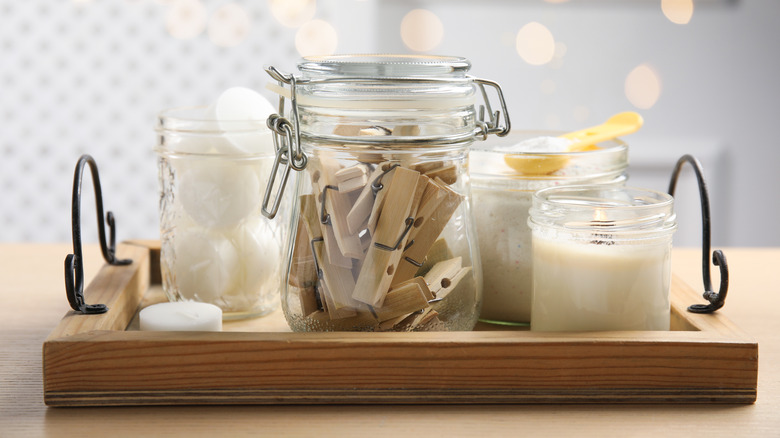How To Use Clamp Jars To Affordably And Aesthetically Organize Your Home
We may receive a commission on purchases made from links.
If you're seeking to bring additional order to your home, you might be baffled by just how expensive various popular organizational resources are. While they look amazing, products like acrylic plastic bins can easily cost $10 to $15 per container — when you're revamping a number of spaces, you could be paying some serious money for all the containers you need. There is another resource, humble though it may be, that can provide you with an aesthetically pleasing and affordable way to make your home more organized: clamp jars.
Clamp jars were created back in the late 1800s and became very popular for their ability to be opened and closed quickly with an airtight seal (it is for this reason that they were referred to as lightning jars). Today, it's common to see them in kitchens where they might hold pickled vegetables as their seal can prevent bacteria growth and keep flavors fresh. These benefits, however, also can extend to a number of household products that are best kept sealed and away from exposure to moisture. For a small price, you can stock up on small to big sizes of these glass jars, which offer a clear visual into their contents. A four-pack of Encheng 32-ounce jars is $23, and comes with labels, while a three-pack of ComSaf 78-ounce jars is $26. Since they are made from sustainable and durable materials like glass, metal, and just a small amount of rubber for the seal, you can get unlimited use out of these containers, too.
How to use clamp lid jars around the house
If you enjoy removing products from their flashy original packaging, clamp jars are the solution you didn't know you needed. Next time you get home from the grocery store with dishwasher pods, you can easily remove them from the product bag and place them in a clamp lid jar under the sink. You can do the same for garbage disposal freshening pods, or any other pre-portioned cleaning tablets that need to be kept away from water but still easy to access. Dry foods — think pasta, rice, oats, and legumes — as well as baking ingredients, like sugar and flour, can be stored in this manner as well.
Even if you don't care about the aesthetics, it's sometimes necessary to repackage certain products — such as laundry powders — when their cardboard boxes tear and spill their contents. Once again, clamp jars are the ideal solution. To rehome your washing soda, borax powder, or powdered laundry detergent, cut the box on an angle so that you can easily pour the powder into your new glass jars. In some cases, you might need to use a funnel to cut down on accidental spills.
To give your bathroom a bit of a cozy and spa-like feel, pour your epsom salts into a clamp jar and keep it either on the counter or next to the bathtub. Do the same with your colorful bath bombs or any soaking minerals you enjoy. Grab a couple smaller clamp jars to hold personal hygiene tools like disposable nail files, Q-tips, cotton balls, or make-up removal rounds. Whether you're storing them out in the open or have them concealed in a cabinet, the minimalist visual continuity will bring peace and order to your space.
Optimizing clamp lid jars for regular use
As great as clamp lid jars are on their own, there are a few ideas to keep in mind to make implementing them much easier. For starters, one drawback of removing products from their original packaging is that they can be difficult to identify. Have some labels handy to place on your jars so you can clearly mark what they contain — or, make some chic labels yourself with packing tape. To make your clamp jars a true asset instead of a hassle to use, you'll also need to get yourself a few scoops for measuring out laundry powders, epsom salts, soaking minerals, and the like. Use whatever scoops you have around the house, or purchase something a little cuter, like these cast aluminum scoops from Update International.
If you're planning on using clamp lid jars for various powders around the home, remember that even the slightest amount of moisture can result in clumping (or mildew, if you're using the jars for cotton balls, Q-tips, etc.). The best way to avoid this is to make sure the jars are thoroughly dry after you wash them. Removing the seal and drying around the neck of the jar will also eliminate any lingering moisture and help preserve the contents of the containers. With a relatively small budget, you can revamp storage of household items, gaining a better-looking and better-performing solution.


